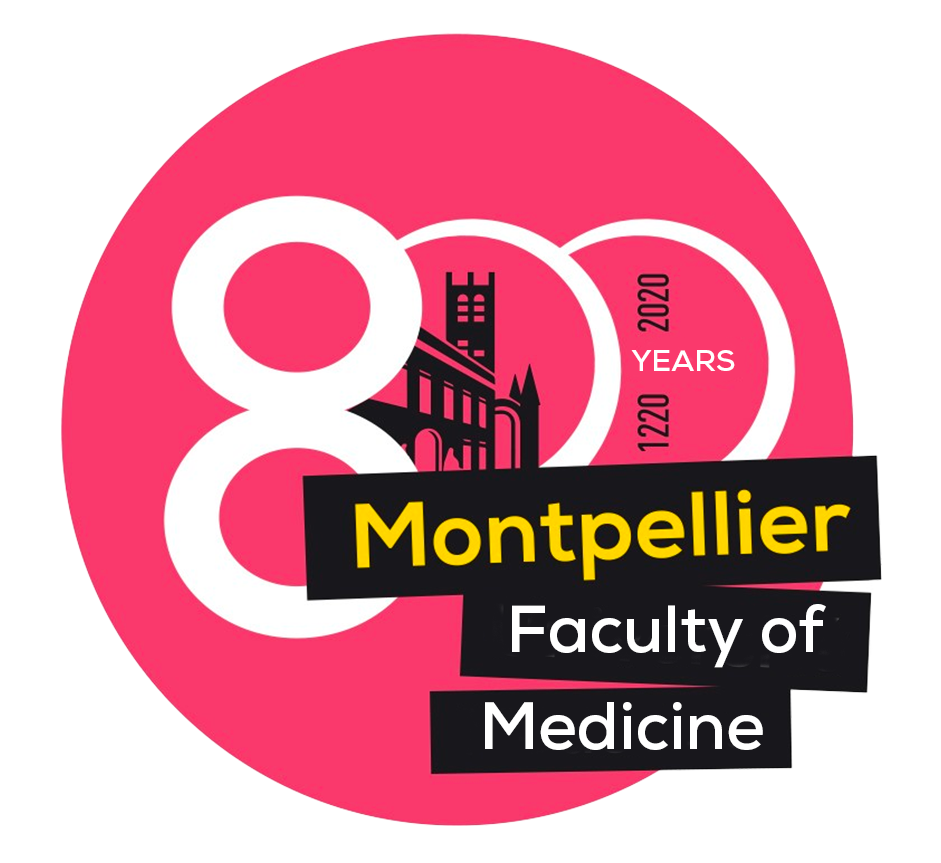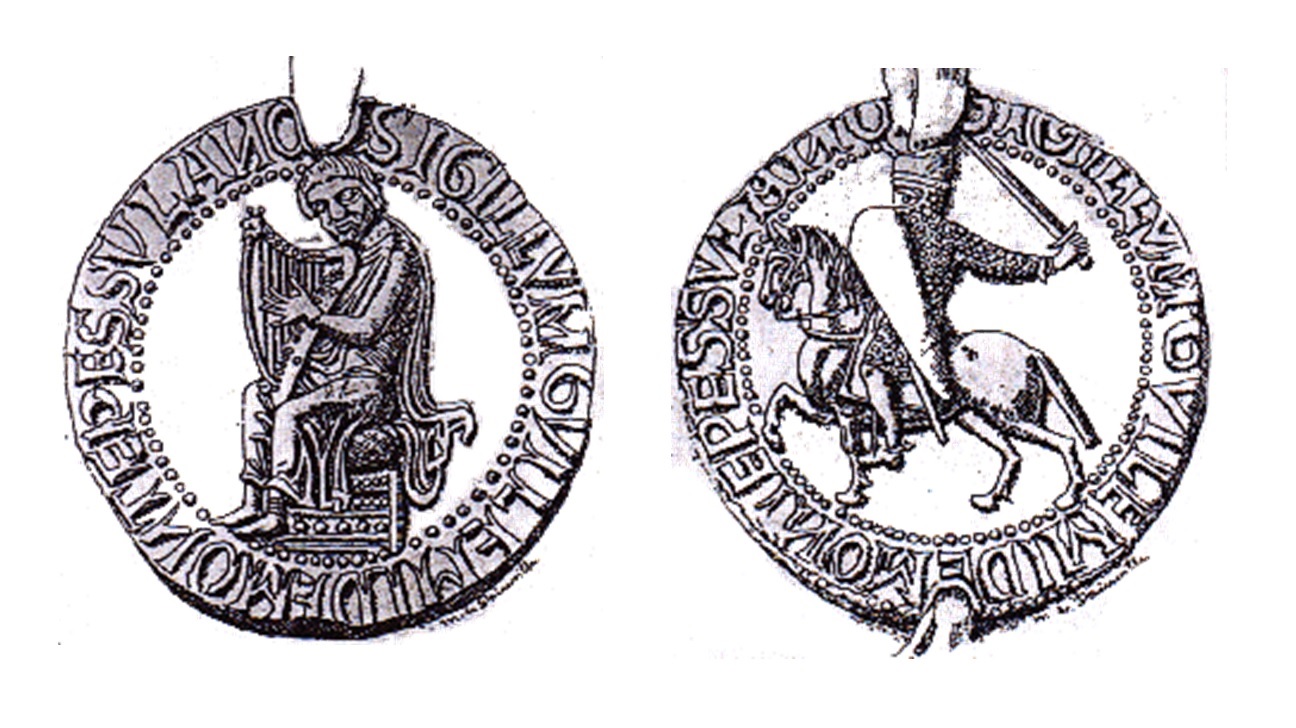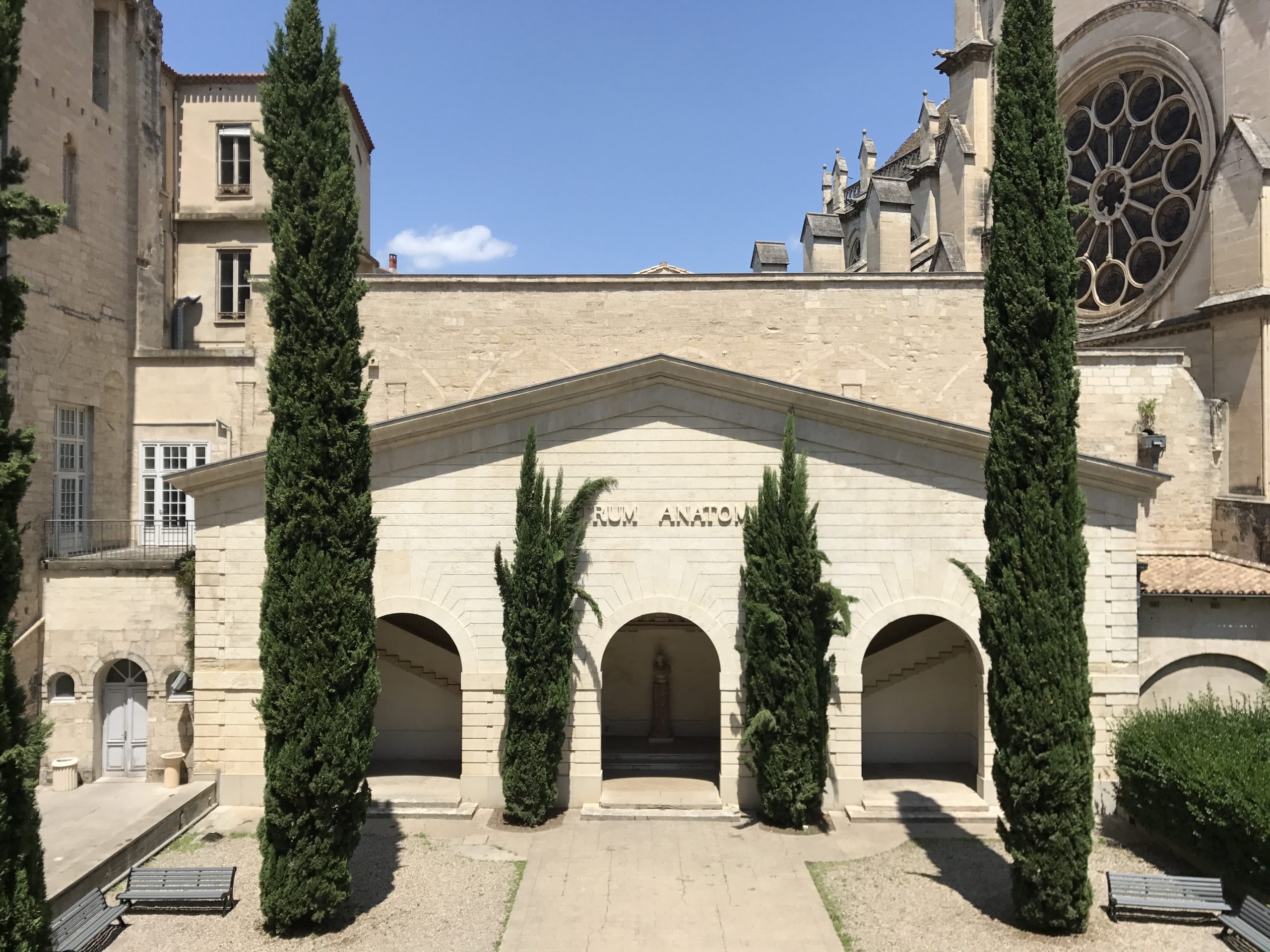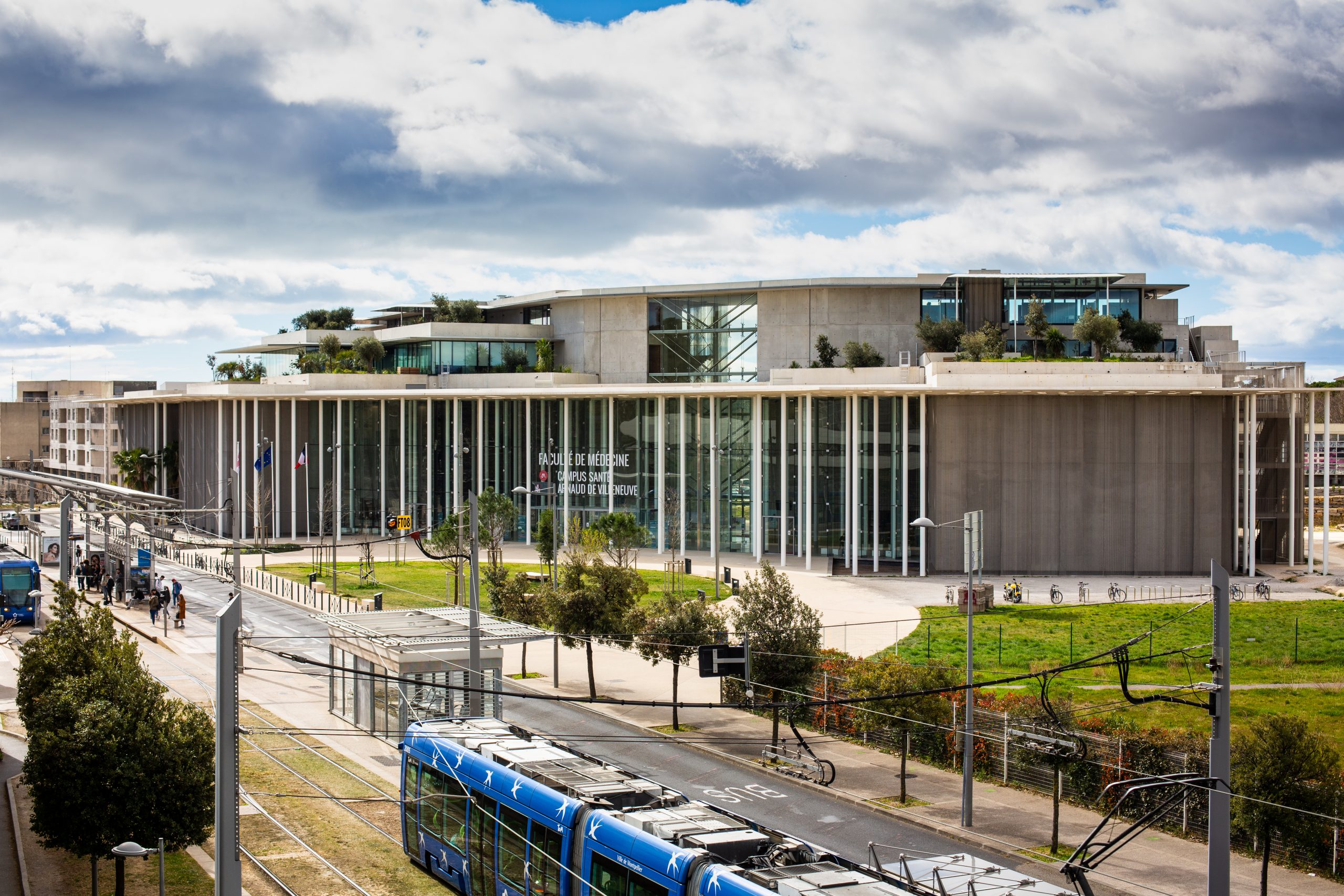KEY DATES OF THE FACULTY OF MEDICINE:
985 TO TODAY
From 985 to 1204
985
The Count of Melgueil (today the township of Mauguio) gives William V a plot of agricultural land on the outskirts of Villa Montepestelario. This became the site of Montpellier, a new city founded in 1000, of which William V became lord.
1085
The county of Melgueil (which included Montpellier) is donated to the pope.
1137
First record of the presence of reputed physicians in Montpellier.
1181
Declaration of William VIII concerning the teaching of medicine in Montpellier: a specific master, a specific school, no monopoly on education and no regulations. This was the archetypal model of higher education (notably in law and medicine) that flourished in the 12th century in western Europe.
1204
Montpellier becomes part of the Kingdom of Aragon and remains under the rule of the pope.
From 1220 to 1340
1220
Cardinal Conrad of Urach, the papal legate to Pope Honorius III, issues a statute deeming the medical school of Montpellier ‘a university for doctors as well as students’. This was a new direction from William VIII’s declaration 40 years before. This university statute was the first time in history that teaching medicine was ‘officialized’ with a structure and legal requirements – giving us the meaning of the term ‘university’ as it is still understood around the world today. More than a school, a ‘university’ was an officially recognized group (universitas means ‘community’ in Latin) of teachers qualified to instruct under the direction of a chancellor or dean, with reciprocal obligations and duties between students and the teaching community. This structure was overseen by the authority of the day (in the 13th century, the Catholic Church), particularly in relation to the right to teach, the right to study and the control of knowledge (that is, the delivery of a diploma and its recognition throughout the territory governed by the authority). The statutes deeming the medical school in Montpellier a ‘university’ in 1220 contain all these legal elements, allowing the ‘universal’ recognition of a diploma in medicine across the Christian world, in a similar way to a current diploma being accepted throughout the European Union. From 1220, Montpellier was henceforth a true ‘medical university’.
1260
Arnaud de Villeneuve, originally from Valencia, comes to Montpellier to study medicine. He would become a highly regarded doctor in the Middle Ages and the physician to the kings of Aragon. He exported medical texts in Arabic and Persian and was an eclectic mix of pharmacologist and alchemist. In 1299, on a mission to the King of France (Philip the Bold) his religious positions landed him in prison.
1289
A papal bull issued by Pope Nicholas IV groups together the faculty of medicine, the faculty of law and the faculty of arts in a studium generale, considered as the foundation of the University of Montpellier.
1325
Gui de Chauliac from the Lozère, north of Montpellier, comes to the university to study medicine. He is considered one of the pioneers of surgery, in an era when the practice was viewed in a bad light by church physicians who ‘did not like blood’. Gui de Chauliac wrote a major work on surgery (La Grande Chirurgie), a rare example of scientific and pedagogical modernity for its time that was studied until the 18th century. It was dedicated to the doctors of Montpellier.
1340
The first ‘official’ organization of anatomical dissections in Montpellier: at least one every two years! Gui de Chauliac himself autopsied patients who were victims of the bubonic plague in Montpellier.
From 1348 to 1369
1348
The Black Death adds to the ravages of the Hundred Years War, a dark period in history during which companies of mercenaries wreaked havoc in Languedoc.
1349
Montpellier becomes part of the Kingdom of France.
1367
Inauguration of Montpellier’s Saint Benoît and Saint Germain College, constructed at the request of Pope Urban V by the architects of the Palace of the Popes in Avignon. The establishment was a college and residence for students of canon law and theology. Built on the edge of the city ramparts, its fortress-like architecture reflects this difficult period of medieval history. In 1536, it became the bishopric. Expropriated during the French Revolution as religious property, in 1795 the building became the ‘School of Health’: the post-revolutionary name given to the medical school. Today the iconic building remains the historic site of the Montpellier Faculty of Medicine.
1369
The foundation of the College of the Twelve Doctors (also known as the College of Mende) by Pope Urban V and his brother, Cardinal Anglic Grimoard. It lodged, fed and educated 12 medical students of modest means from the Lozère region. The location chosen for the site was in a street where many doctors from the medical school lived and worked.
From 1452 to 1556
1452
The creation of the College of Girona for medical students from Catalonia on a site just opposite the College of Mende. At this time, the medical school did not yet have its own teaching premises.
1498
The official creation of the Royal College of Medicine, in an extension of the street where the colleges of Mende and Girona were located. This was the very first site specifically dedicated to the Faculty of Medicine. Before this date, meetings, scientific discussions and thesis presentations were held in Montpellier churches such as Saint Firmin and Notre Dame des Tables. The Royal College of Medicine remained an active faculty for 300 years until it was closed by the National Convention after the Revolution.
1529
Nostradamus, from the region of Provence, enrolled as a student at Montpellier’s medical school … and was then expelled. His enrolment was rejected by Rondelet, a professor of medicine and the student registrar. The reason was that Nostradamus had received apothecary training, which was not permitted in medicine; at the time, pharmacy was considered a manual profession in the same way as surgery. A record of a medical consultation Nostradamus gave the Bishop of Béziers, the future Cardinal Strozzi, is conserved in the Hérault archives in Montpellier. It already contains references to astrology.
1530
François Rabelais, from the province of Touraine, enrols to study medicine in Montpellier. He became a doctor in 1537 and taught anatomy for a period. He left evidence of his time at the medical school in his 1532 fictional work Gargantua and Pantagruel, in which he describes a scene following a thesis presentation with faculty medical professors including Rondelet (the character Rondibilis). Often described as the archetypal naughty medical student (‘Live happily’ is his advice in his novel), Rabelais was above all a Renaissance humanist, freethinker and philosopher. His famous maxim in a letter from Gargantua to his son Pantagruel has become the cornerstone of modern bioethics: ‘Science without conscience is but the ruin of the soul.’
1556
The Montpellier native Guillaume Rondelet is appointed Chancellor of the Faculty (the equivalent of a dean today). Rondelet embodied the quintessential Renaissance naturalist physician, interested in both humans and the nature that surrounds them. His treatise on marine animals was a systematic study of the animal kingdom that was long a standard reference work. His efforts led to the construction of the first anatomy theatre for dissections and the first botanical garden for medicinal plants, both at Montpellier’s Royal College of Medicine.
From 1593 to 1757
1593
The creation in Montpellier of France’s first botanical garden by Pierre Richer de Belleval, a professor at the faculty whose efforts were financed by Henry IV, King of France. Ever since, each director of the botanical garden has been a professor at the medical school. This tradition bears witness to the humanist and naturalist philosophy of Montpellier’s Faculty of Medicine, which considers medical science a ‘study of humankind’ in all its dimensions, including the environment. The current director of the botanical garden is Prof Thierry Lavabre-Bertrand, a haematologist and professor of histology and cytology, who also holds a PhD in history and is the committee chairman of the 800th anniversary events, a vice-dean, and the vice-president of cultural heritage at the university.
1622
Siege of Montpellier, a Protestant stronghold, by the Catholic forces of King Louis XIII during the Wars of Religion. The botanical garden, the bishopric and the adjacent Saint Pierre Cathedral were destroyed, but were later reconstructed.
1659
The Montpellier native Pierre Magnol is awarded a degree in medicine, following which he began to study and then teach botany. He became steward of the botanical garden in 1694, and received the title of ‘Inspector of the Garden’ in 1697 for the remainder of his life. Magnol is one of the innovators who devised the botanical scheme of classification, publishing the concept of plant families as they are understood today. The genus Magnolia was named after him. The term ‘taxonomy’ was coined later, in 1813, by Augustin-Pyrame de Candolle, chair of botany at the University of Montpellier.
1695
The Montpellier native François Gigot de Lapeyronie is awarded a diploma of barber-surgeon from the Faculty of Medicine. Later he became the surgeon-major at the Saint Eloi Hospital. Rapidly recognized as a skilled and effective surgeon, he became first surgeon to King Louis XV, and from 1736 to 1747, the president of the Royal Academy of Surgery. He is thought to be at the origin of the royal ordinance of 1743 that definitively separated the profession of surgeon and barber. Lapeyronie is represented by the statue on the left of the entrance to the historic Faculty of Medicine. The statue on the right is the physician Paul-Joseph Barthez. The frame of the door may symbolize the union between surgeons and doctors, henceforth students and teachers at the same faculty.
1757
Inauguration of the Hôtel Saint Côme, created by Lapeyronie for the Royal College of Surgeons to use as a lecture hall. It was modelled on the Saint Côme amphitheatre in Paris. Today it is the headquarters of Montpellier’s Chamber of Commerce.
From 1761 to 1803
1761
The Montpellier-born Paul-Joseph Barthez is named a professor of anatomy and botany at the medical school. He became Chancellor of the Faculty in 1785. He was the epitome of an Enlightenment physician-philosopher and encyclopaedist. His book New Elements of the Science of Man in 1778 was the founding work of the biological theory of vitalism, a philosophical doctrine that attempted to explain the living world and a forerunner to biology. Barthez is represented by the statue on the right of the entrance to the historic Faculty of Medicine.
1792
Closure by the National Convention of all universities in France, whatever their field, for being under the authority of the church. Teaching medicine became ‘unofficial’ in Montpellier, no longer supported by the monarchy but by the municipality. The faculty was renamed the National School of Medicine and was the sole medical school still operating in France.
1794
In the public (and military) interest, three medical schools are reopened: in Montpellier, Paris and Strasbourg. These were the first institutes of higher learning to reopen after the Revolution.
1795
The medical school is moved to the bishopric of Montpellier despite the latter still being occupied! The school owes this ‘takeover’ to one of its professors, Jean-Antoine Chaptal from Lozère, a chemistry professor and politician, director of the gunpowder magazine in Paris (1794), and later the Minister of the Interior to Napoléon Bonaparte (1801). Chaptal is responsible for adapting the architecture of the bishopric to teach medicine, including the construction of the Theatrum Anatomicum: the anatomical theatre for dissections. He also reconstituted the university library, assembling the best works of all time from revolutionary collections throughout France and Europe (including Carolingian manuscripts and incunabula – early printed books), in all fields of knowledge. Since 1795 (for 225 years), thesis presentations for Montpellier medical students have been held in the faculty’s Hall of Acts, the former chapel of the bishop.
1803
Creation by Napoléon of Montpellier’s School of Pharmacy, which occupied the former Royal College of Medicine. Today this building takes the name Panacée (French for Panacea, the Greek goddess of universal remedy) and houses studios for artists and an exhibition space that is part of Montpellier’s Contemporary Art Centre (MOCO), an ecosystem that also includes Montpellier’s School of Fine Arts and the Hôtel des Collections.
From 1808 to 1859
1808
Montpellier’s medical school becomes the Faculty of Medicine, following the creation of the imperial university by Napoléon. This name is still used today by students and teachers as well as the general public in preference to the official administrative acronyms for faculties in force in France since 1968 (i.e. UFRs: Education and Research Units).
1813
First donations by the art collector Xavier Atger to the Faculty of Medicine – works which will form the future collection of the Musée Atger. This is the oldest art museum in Montpellier and is located in the historic faculty building. The presence of an art collection in such a site may seem unusual, yet it is a conscious choice that is consistent with the humanist vision of medicine promoted by Montpellier’s medical school. Openness to art is seen as an additional dimension in understanding humans that can be useful to future doctors.
1813
Creation of the term ‘taxonomy’ by the Swiss doctor and botanist Augustin-Pyrame de Candolle, chair of botany at the Faculty of Medicine, then director of the botanical garden and superintendent of schools in the academic district of Montpellier during the 100 days of Napoléon’s rule after his return from exile in 1815.
1819
The botanist Alire Raffeneau-Delile from Versailles is named director of the botanical garden – a position he held for 31 years, until 1850. He introduced the Nile water lily to the gardens, a plant he had discovered as the official botanist on Napoléon’s campaign in Egypt.
1859
Enrolment of the future impressionist and naturalist painter Frédéric Bazille at the Faculty of Medicine. He continued to study medicine when he moved to Paris.
From 1878 to 1921
1878
The Scottish student Agnes McLaren was the first woman to receive a medical degree from Montpellier’s Faculty of Medicine following the presentation of her thesis, entitled ‘Flexions of the uterus’. During her career as a doctor, she was unflagging in her aid for poor women. The high-tech gynaecology and obstetrics simulation training centre at the new Arnaud-de-Villeneuve medical campus is named in her honour.
1890
Commemoration of the 600th anniversary of the University of Montpellier, dated from the studium generale created by papal bull in 1289 (and celebrated one year later), under then French President Sadi Carnot.
1893
Enrolment at the Faculty of Medicine of the Russian student Glafira Ziegelmann. A brilliant student, she was the first woman to be admitted for the internship exam for provincial hospitals in 1897, and the first female clinic director at the faculty (in gynaecology and obstetrics) in 1903. After anonymously passing a written test for a medical teaching diploma in 1910, she was warned by the jury in Paris not to appear for the oral presentation as she was a woman. A theatre is named after her at the new Arnaud-de-Villeneuve medical campus.
1914
The first blood transfusion in Montpellier is performed by Prof Emile Jeanbrau, who had developed a modern transfusion technique by flask. This technique replaced arm-to-arm transfusion through the use of an anticoagulant (sodium citrate), a breakthrough developed by another Montpellier doctor, Prof Emmanuel Hédon. Jeanbrau carried out the first flask transfusion in his surgical ambulance on the front in 1917. He was then asked by the Health Service to transmit this information throughout the army. So those soldiers receiving transfusions in 1917 and 1918 owe him, in part, their lives. Jeanbrau continued his work after the war, heading up the first blood transfusion centre in Montpellier in 1933.
1921
Commemoration of the seventh centennial of the University of Montpellier (celebrated one year later), under then French President Alexandre Millerand.
From 1941 to 1968
1941
Gaston Giraud is appointed dean and defends the Faculty of Medicine from the excesses of the German occupation during World War II. He remained dean until 1960 (for 19 years), carrying out many works of restoration, such as extending the historic faculty and the Institute of Biology to provide new faculty sites all along Boulevard Henri IV.
1942
The discovery by Prof Marcel Jambon and the experimental validation by Prof Auguste Loubatières of the hypoglycaemic potential of sulfonamides, leading to the development of the first oral hypoglycaemic drugs, a major advance in the treatment of type 2 diabetes.
1958
The creation in France of university hospitals (Centres Hospitaliers Universitaires: CHUs) in the framework of the medical education reform launched by Prof Louis Debré. The Faculty of Medicine becomes part of the Montpellier University Hospital.
1968
Social revolution
1968
Administrative shakeup of higher education (introduced by the Edgar Faure law), in which faculties were first renamed Teaching and Research Units (Unités d’Enseignement et de Recherche: UERs), and later in 1984 became Education and Research Units (Unités de Formation et de Recherche: UFRs). Nonetheless, people still continued to use the more popular term ‘faculty’.
1968
A branch of the medical school was created at the Nîmes Hospital, which welcomed student interns from 1960, before becoming an official university hospital in 1971. The following year, a Faculty of Medicine site was constructed in Nîmes. Today, one-third of the medical students of the joint Montpellier-Nîmes Faculty of Medicine study in Nîmes.
From 1985 to today
1985
Millennium celebration of the founding of the city of Montpellier
2011
First successful use of a ‘self-contained artificial pancreas’ in humans is demonstrated in Montpellier. This advance in the treatment of type 1 diabetes is the result of an international project based in Montpellier and led by Prof Jacques Bringer (dean of the Faculty of Medicine) and Prof Eric Renard.
2014
Inauguration of the Salle Delmas-Orfila-Rouvière which houses the 3 anatomy collections of the Faculty of Paris Descartes in the historic building, as well as the Spitzner collection. These major collections in the history of anatomy, including the internationally renowned "Anatomical Wax Venus", were bequeathed to the Faculty of Montpellier. It therefore has the largest anatomical collection in France and one of the largest in Europe (more than 13,000 pieces).
2015
The merging of University of Montpellier 1 (created by the Faure law of 1968 and which has included the Faculty of Medicine since 1971) and University of Montpellier 2 (Faculty of Science) into a single University of Montpellier. A third university remains separate: University Paul Valéry Montpellier 3 (Faculties of Literature, Arts, Languages and Human and Social Sciences).
2017
Inauguration of the Arnaud-de-Villeneuve campus of the medical school. Designed by the architect François Fontès, this ultra-modern site makes the Faculty of Medicine of the University of Montpellier both the oldest and the newest in France! Exactly 650 years separate the opening of this iconic new medical school building from the inauguration in 1367 by Pope Urban V of the Saint Benoît and Saint Germain College, Montpellier’s historic Faculty of Medicine.
2020
The commemoration of 800 years of existence of the Montpellier Faculty of Medicine, the oldest medical school in Europe, and ‘officially’ the oldest in the world in the conceptual and legal meaning of the term ‘university’ as it is understood around the world today.










